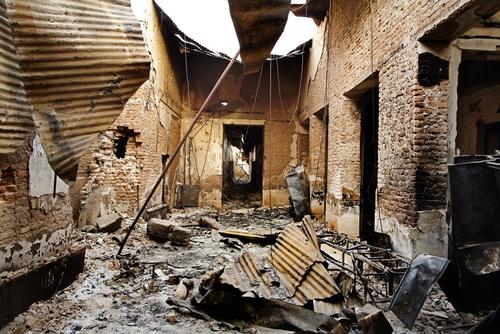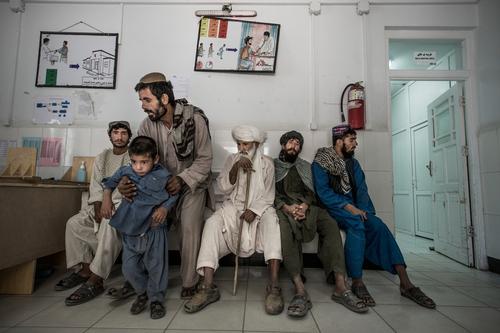- What was the physical description of the intended target provided by the Afghan forces and how did it match the description of the MSF hospital?
- Which forces – either U.S. or Afghan – on the ground had ‘eyes on the target’ [National Directorate of Security compound] before and during the attack? And if the U.S. did not, why not?
- During the airstrike, how many calls or warnings were recording from Afghan Special Forces to the U.S. Special Forces commander or the Joint Terminal Attack Controller to inform them of the targeting error, i.e. that the intended target (National Directorate of Security compound) was not being hit?
- Why was the attack not called off before the AC-130 completed its mission? Who would have been responsible to call off the attack of an AC-130 deprived of its essential communication capacity operating in a densely populated area? And why didn’t he/she?
- How do you reconcile the difference in the duration of the attack between the U.S. version of events and the MSF internal review?
- Given that U.S. troops were not directly under fire, what are the limits of engagement of U.S forces in combat activities?
- How do you justify that no court martial is recommended in response to the killing of 42 people and considering the protected status of the hospital?
- Who within the chain of command is ultimately responsible for the deaths of 42 people, and how is that person being held accountable?
- Does the U.S. consider the actions of U.S. forces to be negligent, and if not, why?
- How will the disciplinary measures chosen deter U.S. military personnel from violating the laws of war in the future?
About Us
See what triggers an intervention and how supply and logistics allow our teams to respond quickly.
Learn more How we workDiscover our governance and what it means to be an association. Find a quick visual guide to our offices around the world.
Learn more How we're runRead through our annual financial and activity reports, and find out about where our funds come from and how they are spent.
Learn more Reports and financialsRead the policies, reports, and plans on how we address issues like racism and reduce our carbon footprint, ensuring our actions align with the highest ethical standards.
Learn more AccountabilityVisit this section to get in touch with our offices around the world.
Learn more Contact usWhat we do
Médecins Sans Frontières brings medical humanitarian assistance to victims of conflict, natural disasters, epidemics or healthcare exclusion.
View all topics Activities by country
Learn about how, why, and where MSF teams respond to different diseases around the world, and the challenges we face in providing treatment.

Learn about the different contexts and situations in which MSF teams respond to provide care, including war and natural disaster settings, and how and why we adapt our activities to each.

Learn about our response and our work in depth on specific themes and events.
Where we work
In more than 70 countries, Médecins Sans Frontières provides medical humanitarian assistance to save lives and ease the suffering of people in crisis situations.
View all countriesMSF Websites
- Argentina
- Australia
- Austria
- Belgium
- Brazil
- Canada
- China
- Colombia
- Czech Republic
- Denmark
- Eastern Africa
- Finland
- France
- Germany
- Greece
- Holland
- Hong Kong
- India
- Indonesia
- Ireland
- Italy
- Japan
- Lebanon
- Luxembourg
- Malaysia
- Mexico
- New Zealand
- Norway
- Pakistan
- Philippines
- Poland
- Russian Federation
- Southern Africa
- South Korea
- Spain
- Sweden
- Switzerland
- Taiwan
- Thailand
- UAE
- UK
- Uruguay
- USA
We set up the MSF Access Campaign in 1999 to push for access to, and the development of, life-saving and life-prolonging medicines, diagnostic tests and vaccines for people in our programmes and beyond.
GO TO SITE Access CampaignBased in Paris, CRASH conducts and directs studies and analysis of MSF actions. They participate in internal training sessions and assessment missions in the field.
GO TO SITE CRASHBased in Geneva, UREPH (or Research Unit) aims to improve the way MSF projects are implemented in the field and to participate in critical thinking on humanitarian and medical action.
GO TO SITE UREPHBased in Barcelona, ARHP documents and reflects on the operational challenges and dilemmas faced by the MSF field teams.
GO TO SITE ARHPBased in Brussels, MSF Analysis intends to stimulate reflection and debate on humanitarian topics organised around the themes of migration, refugees, aid access, health policy and the environment in which aid operates.
GO TO SITE MSF AnalysisThis logistical and supply centre in Brussels provides storage of and delivers medical equipment, logistics and drugs for international purchases for MSF missions.
GO TO SITE MSF SupplyThis supply and logistics centre in Bordeaux, France, provides warehousing and delivery of medical equipment, logistics and drugs for international purchases for MSF missions.
GO TO SITE MSF LogistiqueThis logistical centre in Amsterdam purchases, tests, and stores equipment including vehicles, communications material, power supplies, water-processing facilities and nutritional supplements.
GO TO SITE Amsterdam Procurement UnitBRAMU specialises in neglected tropical diseases, such as dengue and Chagas, and other infectious diseases. This medical unit is based in Rio de Janeiro, Brazil.
GO TO SITE Brazilian Medical UnitOur medical guidelines are based on scientific data collected from MSF’s experiences, the World Health Organization (WHO), other renowned international medical institutions, and medical and scientific journals.
GO TO SITE MSF Medical GuidelinesProviding epidemiological expertise to underpin our operations, conducting research and training to support our goal of providing medical aid in areas where people are affected by conflict, epidemics, disasters, or excluded from health care.
GO TO SITE EpicentreEvaluation Units have been established in Vienna, Stockholm, and Paris, assessing the potential and limitations of medical humanitarian action, thereby enhancing the effectiveness of our medical humanitarian work.
GO TO SITE Evaluation UnitsMSF works with LGBTQI+ populations in many settings over the last 25-30 years. LGBTQI+ people face healthcare disparities with limited access to care and higher disease rates than the general population.
GO TO SITE LGBTQI+ Inclusion in Health SettingsThe Luxembourg Operational Research (LuxOR) unit coordinates field research projects and operational research training, and provides support for documentation activities and routine data collection.
GO TO SITE LUXORThe Intersectional Benchmarking Unit collects and analyses data about local labour markets in all locations where MSF employs people.
GO TO SITE Intersectional Benchmarking UnitTo upskill and provide training to locally-hired MSF staff in several countries, MSF has created the MSF Academy for Healthcare.
GO TO SITE MSF Academy for HealthcareThis Guide explains the terms, concepts, and rules of humanitarian law in accessible and reader-friendly alphabetical entries.
GO TO SITE Humanitarian LawThe MSF Paediatric Days is an event for paediatric field staff, policy makers and academia to exchange ideas, align efforts, inspire and share frontline research to advance urgent paediatric issues of direct concern for the humanitarian field.
GO TO SITE MSF Paediatric DaysThe MSF Foundation aims to create a fertile arena for logistics and medical knowledge-sharing to meet the needs of MSF and the humanitarian sector as a whole.
GO TO SITE MSF FoundationA collaborative, patients’ needs-driven, non-profit drug research and development organisation that is developing new treatments for neglected diseases, founded in 2003 by seven organisations from around the world.
GO TO SITE DNDiOur digital portal dedicated to sharing the latest medical evidence from our humanitarian activities around the globe.
GO TO SITE MSF Science PortalNoma is a preventable and treatable neglected disease, but 90 per cent of people will die within the first two weeks of infection if they do not receive treatment.
GO TO SITE NomaThe TIC is aiming to change how MSF works to better meet the evolving needs of our patients.
GO TO SITE TICMSF's telemedicine hub aims to overcome geographic barriers for equitable, accessible, and quality patient care.
GO TO SITE TelemedicineLaunched in 2012, the MSF Sweden Innovation Unit deploys a human-centered approach for promoting a culture of innovation within MSF.
GO TO SITE Sweden Innovation Unit

